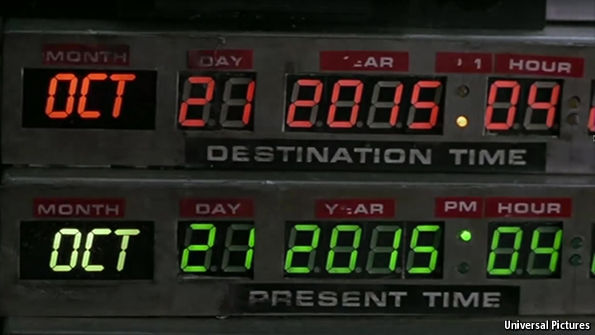From The Economist, Oct 26th 1985, 11:48 BY THE DATA TEAM:
TODAY, October 21st 2015, film fans of a certain age (including a number of Economist staff) celebrate the “Back to the Future” trilogy. The films—released between 1985 and 1990—follow the two lead characters, Dr Emmett Lathrop* Brown and Marty McFly (an eccentric inventor and his teenage schoolboy friend) as they travel through time in a machine converted from a DeLorean motor car. The significance of the date? Today is the day the characters travelled to and from their home year of 1985 (the exact date is revealed on the time-machine’s dashboard readout).

Over the course of the trilogy, McFly also travels from his home time and home town to the same location in 1955 and 1885. But it is when visiting the future that he purchases a copy of a sports almanac with the intent to cheat 1985's bookmakers with foreknowledge of baseball results. It is no spoiler to reveal that all does not go to plan. If instead he’d spent his money on copies of The Economist (it would have been on sale across all of the three eras), what data visualisations might he have encountered accompanying the key issues of each respective year? We took to our own time-machine (The Economist digital archive) to find out:
Upon opening the edition of September 5th 1885 (though it’s questionable whether our circulation would have reached America’s Wild West), Marty wouldn't have discovered much “visualisation” of data as such, but he'd find a newspaper filled with a LOT of tables, such as this example breaking down the fortunes and transactions of the Bank of France.
Arriving on November 5th 1955 (the day that the “Doc” invented time travel, according to the script), McFly would be struck by the sheer volume of advertising in the publication. He would also find a timeline chart of canned goods accompanying a story by a correspondent in California headlined “Too many tins”. Elsewhere in the issue, he’d read about the African territories of British and French Togoland, and their options on combining, joining the soon-to-be independent Gold Coast, or remaining under the sovereignty of their respective ruling nations (British Togoland eventually joined Gold Coast, forming what is now Ghana)....MORE
Here's that 1846 front page:
